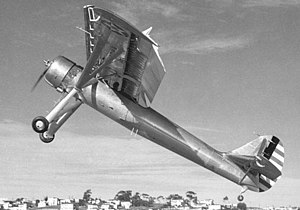| YO-51 Dragonfly | |
|---|---|

| |
| Role | Army observation and liaisonType of aircraft |
| Manufacturer | Ryan Aeronautical |
| First flight | 1940 |
| Primary user | United States Army Air Corps |
| Number built | 3 |
The Ryan YO-51 Dragonfly was an observation aircraft designed and built by Ryan Aeronautical for the United States Army Air Corps (USAAC). A single-engined parasol wing monoplane, it was designed for optimum STOL capability, but although three prototypes proved highly successful in testing, the Stinson YO-49 was judged superior and no production contract was placed.
Design
The design of the YO-51 Dragonfly was typical for aircraft of its type, being optimised for the observation and liaison role, with emphasis on the ability to operate out of the smallest possible airfields. The Dragonfly was a high-wing braced parasol monoplane with fixed tailwheel landing gear, a two-seat open cockpit, and full-span slots and Fowler flaps for STOL capability. It was powered by a single Pratt & Whitney R-985-21 Wasp Junior radial engine.
At gross weight, the YO-51 could, without flaps, take off after a run of 400 feet, while with full flaps the takeoff run would be only 75 feet, or just four feet more than twice its own length. The Dragonfly was capable of maintaining level flight at speeds as low as 30 miles per hour (48 km/h), and was claimed as being capable of landing in a distance shorter than the length of the aircraft itself.
Operational history
Nicknamed the "flying motorcycle", three YO-51 aircraft were acquired by the United States Army Air Corps to take part in a fly-off evaluation against the Stinson YO-49 and Bellanca YO-50 to supply a new observation and liaison aircraft for use by the USAAC. The YO-51 was the heaviest of the three aircraft evaluated.
Although the Dragonfly was considered satisfactory during its flight testing, conducted at Wright Field in Ohio, the Stinson machine won the production contract, and no further YO-51s were built.
Specifications

Data from Donald 1997
General characteristics
- Crew: two (pilot and observer)
- Length: 35 ft 6 in (10.82 m)
- Wingspan: 52 ft (16 m)
- Height: 11 ft 1 in (3.38 m)
- Gross weight: 4,206 lb (1,908 kg)
- Powerplant: 1 × Pratt & Whitney R-985-21 Wasp Junior radial, 440 hp (330 kW)
Performance
- Maximum speed: 129 mph (208 km/h, 112 kn)
- Cruise speed: 107 mph (172 km/h, 93 kn)
- Stall speed: 30 mph (48 km/h, 26 kn)
Armament
- None
See also
Aircraft of comparable role, configuration, and era
- Bellanca YO-50
- Fieseler Fi 156 Storch
- Henschel Hs 126
- Kokusai Ki-76
- Polikarpov Po-2
- Repülőgépgyár_Levente_II
- Stinson L-1 Vigilant
Related lists
References
- Notes
- Penfield 1941, p.31.
- Foottit, H. R. (February 1942). "The Fowler Flap". Flying and Popular Aviation. 30 (2). Chicago: Ziff-Davis Publishing Co.: 71.
- ^ Donald 1997, p.794.
- Fowler 1948, p.79.
- Rowe 2006, p.22.
- Wilson, Gill Robb (July 1954). "Genealogy of American Aircraft". Flying. 55 (1). Chicago: Ziff-Davis Publishing Co.: 23.
- "U. S. Army's "Flying Motorcycle"". The Boston Globe. Boston, MA. May 25, 1941. p. C1.
- Pattillo 2001, p.137.
- Adcock 2005, p.5.
- "The Dragonfly---Army's Newest Observation Plane". The Milwaukee Sentinel. Milwaukee, WI. February 23, 1940. p. 2.
- "Army Tests New B-17C". The New York Times. New York. November 17, 1940. Retrieved 2012-08-11.
- Merriam 2002, p.26.
- Bibliography
- Adcock, Al (2005). US Liaison Aircraft in action. Aircraft in Action. Vol. 195. Carrollton, TX: Squadron/Signal Publications. ISBN 978-0897474870.
- Donald, David (1997). Complete Encyclopedia of World Aircraft. London: Orbis Publishing Ltd. ISBN 0760705925.
- Fowler, Harlan Davey (1948). Fowler Flaps for Airplanes: An engineering handbook. Los Angeles: Wetzel Publishing Co. ASIN B0007EA17Q.
- Merriam, Ray, ed. (2002). World War II Journal #15: U.S. Military Aircraft of World War II. Bennington, VT: Merriam Press. ISBN 1576381676.
- Pattillo, Donald M. (2001). Pushing the Envelope: The American Aircraft Industry. Ann Arbor, MI: University of Michigan Press. ISBN 978-0472086719.
- Penfield, Thomas (1941). Wings for America: Fighting Planes of the U. S. A. Chicago: Rand McNally & Co. ASIN B004BVUSC4.
- Rowe, Frank Joseph (2006). The Helio Courier Ultra C/stol Aircraft: An Illustrated Developmental History. Jefferson, NC: McFarland & Company. ISBN 978-0786422890.
External links
- O-51 Dragonfly at Dave's Warbirds
| Aircraft produced by Ryan Aeronautical and Ryan Airline Company | |
|---|---|
| Ryan Airline Company | |
| Commercial | |
| Fighters | |
| Observation | |
| Trainers | |
| Drones/Missiles | |
| Experimental/ Research | |
| United States observation aircraft designations, USAAC/USAAF and Tri-Service systems | |||
|---|---|---|---|
| USAAC/USAAF sequence (1924–1942) |
| ||
| Tri-Service sequence (1962–present) |
| ||
| Unconfirmed | |||